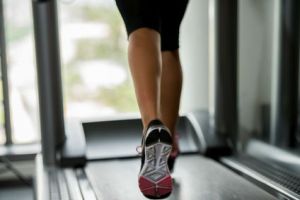
Treadmills are perhaps the most popular piece of exercise equipment around. Over 50 million Americans claim to use them, a statistic that has been growing steadily over the past decade. And while avid road and trail-runners often look at the treadmill with disdain as they far prefer running outdoors, most if not all runners have utilized this piece of equipment for one reason or another.
Whether or not you use the treadmill all the time for workouts or only when outdoor running or walking isn’t viable, there are a few guidelines you should follow to ensure you’re getting the most bang for your exercise buck while staying safe at the same time.
Selecting the wrong screen. Modern treadmills have upright screens that allow a runner’s head to remain in a neutral position. Yet older models place the screen lower (you know the ones with the simulated track comprised of those pesky flashing lights) forcing you to crane your neck into an uncomfortable downward position.
This slumping posture will not only lead to neck pain or headaches, but also limits oxygen consumption which will inhibit your workout. On a similar note, watching those overhead televisions can strain your neck and shoulders and also force you to alter your gait, which can lead to injury.
When selecting a treadmill, choose one in which the screen is directly in front of you. If you are choosing to watch an overhead television, select a treadmill positioned further away so you are not craning your neck backward to see the screen.
Not focusing. Over 19,000 people wind up in hospitals annually because of treadmill accidents. Attempting to read a book, watch television, read the newspaper or ogle yourself in the mirror can lead to a misstep that ultimately can result in a fall.
When exercising, avoid attempting to pass time with other activities and instead focus on your form and rate of exertion. And if you absolutely have to talk on the phone or text, attach the safety lanyard which will halt the belt if you fall.
Using the machine improperly. You wouldn’t begin any exercise with a full-out effort, so neither should you attempt to begin a treadmill session at top speed. Never attempt to step onto a moving belt. Instead straddle the belt until it begins to move at the slowest rate.
Then step on and gradually increase the speed or incline, but not both at the same time. And never jump off the back of a moving treadmill. If you feel the need to stop or slow down, decrease the speed slowly or hit the emergency stop button.
Overestimating caloric expenditure. If you are banking your total caloric expenditure on the screen readout you may be in for a rude awakening. Those numbers are only estimates and the machine cannot take into account a number of factors such as current fitness level, air temperature of the gym and whether or not you stepped off a few times to answer a text message.
And if you are holding on to the handrails you are doing yourself a great disservice as they reduce your effort and the calorie-reaping benefits tremendously. You can use those numbers as an estimate but don’t plan on chowing down on a 300-calorie snack because the treadmill said you burned 350 calories.
Not mixing up your workout. You know the people in the gym who do the same routine every time and wonder why they never see results. Running on the treadmill is not the same thing as running outdoors and you can easily be lulled into thinking you’re working harder than you are (especially if the gym is warm and the sweat is pouring off of you).
 On a treadmill there is no wind resistance or changes in terrain. To account for this work with some incline or speed intervals. For a real change of pace, turn sideways to work the hip and thigh muscles or turn completely around and walk or jog backwards. These variations will ensure you work your leg muscles differently and get the most benefit out of your time running indoors.
On a treadmill there is no wind resistance or changes in terrain. To account for this work with some incline or speed intervals. For a real change of pace, turn sideways to work the hip and thigh muscles or turn completely around and walk or jog backwards. These variations will ensure you work your leg muscles differently and get the most benefit out of your time running indoors.
-The Alternative Daily

